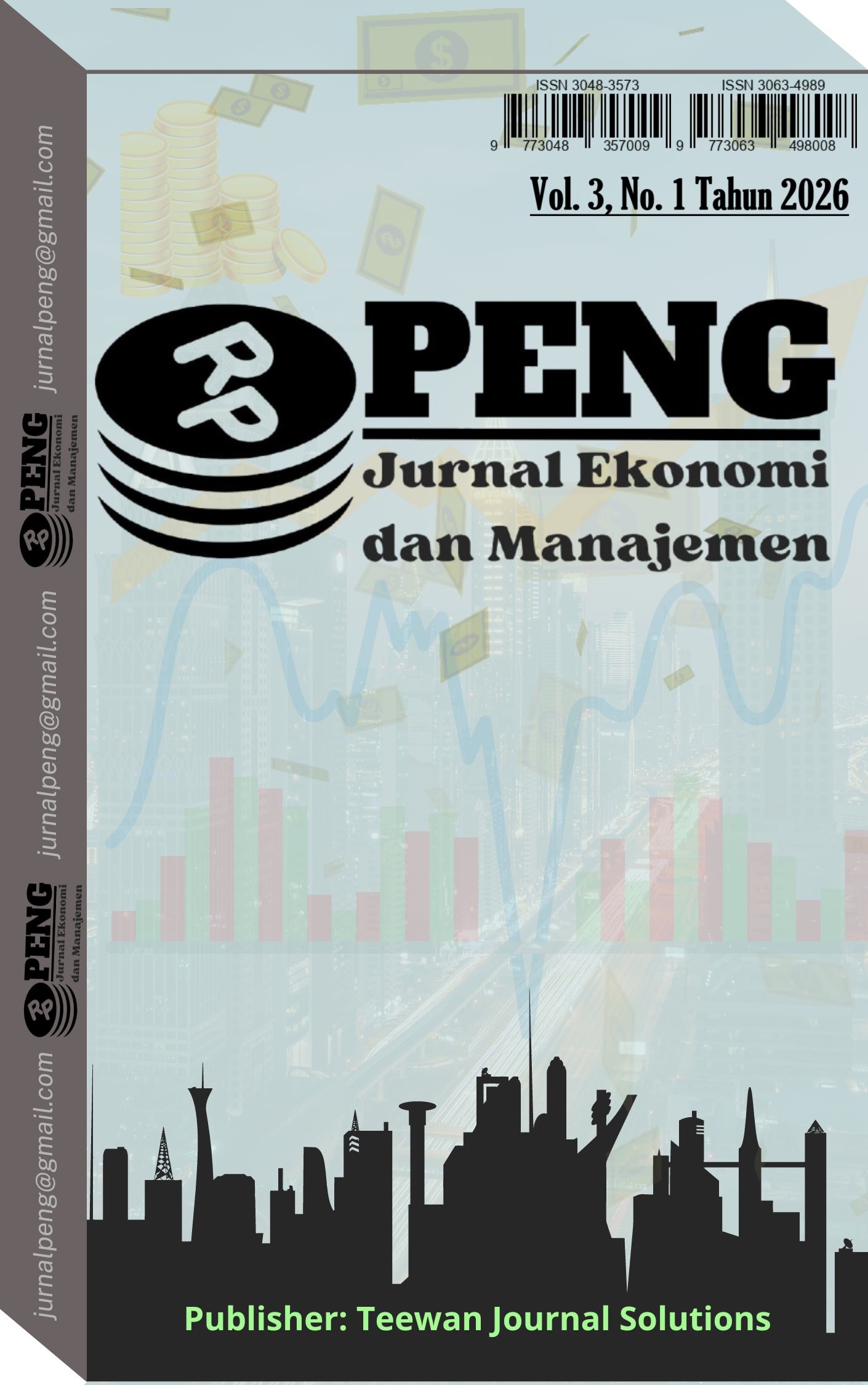Membangun Competitive Advantage GoPay: Peran Product Innovation dan E-Service Quality dengan Mediasi Customer Satisfaction
DOI:
https://doi.org/10.62710/39kwzw77Keywords:
Product Innovation, E-Service Quality, Customer Satisfaction, Competitive Advantage, GoPay.Abstract
This study aims to analyze the influence of Product Innovation, E-Service Quality, and Customer Satisfaction on Competitive Advantage at GoPay. This research uses a quantitative approach with survey techniques through online questionnaires, involving 112 respondents who are GoPay users in Indonesia. The data were analyzed using Partial Least Squares Structural Equation Modeling (PLS-SEM) with the aid of SmartPLS 4 software. The results show that Product Innovation has a significant positive effect on Customer Satisfaction, while E-Service Quality also has a significant positive impact on Customer Satisfaction. Furthermore, Customer Satisfaction was found to have a positive effect on Competitive Advantage. This study also reveals that Product Innovation and E-Service Quality indirectly affect Competitive Advantage through Customer Satisfaction as a mediating variable. The implications of this research emphasize the importance of product innovation and enhancing e-service quality to strengthen customer satisfaction and create a sustainable competitive advantage for GoPay in the face of competition in the fintech industry. These findings can serve as a reference for formulating more effective strategies to maintain GoPay's position in the increasingly competitive digital wallet market.
Downloads
References
Amelia Putri, & Muhammad Irwan Padli Nasution. (2024). 10 PENDAPAT AHLI MENGENAI KEUNGGULAN KOMPETITIF. JOURNAL SAINS STUDENT RESEARCH, 3(1), 98–104. https://doi.org/10.61722/jssr.v3i1.3226
Aslamiyah, F., Adila Windarti, R., Farleni, S., Sanjaya, V. F., & Raden Intan Lampung, U. (2024). Al-A’Mal 176 PENDEKATAN RESOURCE-BASED VIEW (RBV) DALAM MANAJEMEN BISNIS: STRATEGI UNTUK KEUNGGULAN KOMPETITIF YANG BERKELANJUTAN. In Jurnal Manajemen Bisnis Syariah (Vol. 1).
Candra Susanto, P., Ulfah Arini, D., Yuntina, L., & Panatap Soehaditama, J. (n.d.). Konsep Penelitian Kuantitatif: Populasi, Sampel, dan Analisis Data (Sebuah Tinjauan Pustaka). https://doi.org/10.38035/jim.v3i1
Dasuki, R. E., Resource, T., & View…, B. (n.d.). Coopetition : Jurnal Ilmiah Manajemen Manajemen Strategi : Kajian Teori Resource Based View.
Emilia Kurniawati, & Sulastri Rini Rindrayani. (2025). Pendekatan Kuantitatif dengan Penelitian Survei : Studi Kasus dan Implikasinya. SOSIAL : Jurnal Ilmiah Pendidikan IPS, 3(1), 65–69. https://doi.org/10.62383/sosial.v3i1.596
Handayani dan Sarwono (2023). (n.d.).
Memon, M. A., Thurasamy, R., Ting, H., & Cheah, J. H. (2025). PURPOSIVE SAMPLING: A REVIEW AND GUIDELINES FOR QUANTITATIVE RESEARCH. Journal of Applied Structural Equation Modeling, 9(1), 1–23. https://doi.org/10.47263/JASEM.9(1)01
Muhammad Azhar Wijaya, & Epi Fitriah. (2022). Pengaruh Penerapan Analisis Rantai Nilai terhadap Keunggulan Kompetitif. Jurnal Riset Akuntansi, 123–128. https://doi.org/10.29313/jra.v2i2.1408
Novita, D., & Husna, N. (2020). COMPETITIVE ADVANTAGE IN THE COMPANY (Vol. 3, Issue 1).
Perdana Siregar, A., & Setiawan, W. J. (2024). THE ROLE OF LIFESTYLE IN MEDIATING THE INFLUENCE OF DIGITAL TRANSACTION SERVICE INNOVATION ON GO-PAY SERVICE USER DECISIONS. Journal of Business Studies and Management Review (JBSMR), 8(1).
Petković, M. (2023). Corporate News Disclosure and Competitive Advantage: What Factors Influence on S&P 500 Companies’ Competitive Advantage During 2022 Economic Crisis? Economic Analysis, 56(1), 32–42. https://doi.org/10.28934/ea.23.56.1.pp32-42
Rahmayanti, S. R. D., & Oetarjo, M. (2024). E-Service Quality Dynamics and Global Customer Loyalty Impact. Indonesian Journal of Law and Economics Review, 19(2). https://doi.org/10.21070/ijler.v19i2.1061
Randi, H., Suharto, A., & Reskiputri, T. D. (2022). Analisis Pengaruh Brand Ambassador dan Harga pada Aplikasi Ruang Guru terhadap Minat Beli Konsumen pada SMAN 03 Jember. BUDGETING : Journal of Business, Management and Accounting, 4(1), 27–37. https://doi.org/10.31539/budgeting.v4i1.4050
Revathi, M., & Kavitha, P. (2025). THE IMPACT OF PERCEIVED E-SERVICE QUALITY, SERVICE VALUE, USEFULNESS AND TRUST ON CUSTOMER PERCEPTIONS ON E- SERVICE SATISFACTION TOWARDS E-TRAVELING SERVICE. INTERNATIONAL JOURNAL OF MANAGEMENT, 16(2), 62–78. https://doi.org/10.34218/IJM_16_02_006
Siregar, M. B., Dalimunthe, R. F., Rini, E. S., & Absah, Y. (2024). Competitive Advantage in the Era of Society 4.0: A Systematic Literature Review On SDG. Journal of Lifestyle and SDGs Review, 4(2), e01621. https://doi.org/10.47172/2965-730x.sdgsreview.v4.n02.pe01621
Siroj, et.al (2024). (n.d.).
Sudarso, H., Fahrudin, A., & Intang Sappaile, B. (2024). PELATIHAN PENGOLAHAN DATA PENELITIAN MENGGUNAKAN APLIKASI SPSS. In Communnity Development Journal (Vol. 5, Issue 4).
Sunarta, Hana Fadhilah, A. S., & Pamungkas Wibowo, B. (2025). The impact of product innovation and service quality on survival recovery of MSMES: the mediating role of financial performance. Salud, Ciencia y Tecnologia - Serie de Conferencias, 4. https://doi.org/10.56294/sctconf20251314
Susanta, Santosa, H., Hery, Suratna, & Dwi Fadma, R. (2025). Bridging Satisfaction Between E-Service Quality and Brand Pride in Education. SHS Web of Conferences, 212, 04021. https://doi.org/10.1051/shsconf/202521204021
Tarmidi1, D., Salsabila2, A., & Tarmidi, D. (2023). Enrichment: Journal of Management The effect of service innovation and e-service quality toward customer satisfaction the my-xl application in bandung city. In Enrichment: Journal of Management (Vol. 13, Issue 1).
Tuan, K. M., Trang, K. H., & Quan, N. H. (2022). COMPREHENSIVE REVIEW OF THE SOURCES OF COMPETITIVE ADVANTAGES. Hue University Journal of Science: Economics and Development, 131(5B). https://doi.org/10.26459/hueunijed.v131i5b.6828
Wanyama, R., Deya, J., Kariuki, P., & Gachambi, P. (n.d.). Strategic Sensitivity and Competitive Advantage. International Journal of Social Science and Humanities Research, 2(2), 329–338. https://doi.org/10.61108/ijsshr
Wulandari, E., Faturrohman, H., Widodo, S. T., Wahyuni, N. I., Ningsih, F., Guru, P., Fakultas, S. D., Pendidikan, I., & Psikologi, D. (n.d.). PENGARUH PENGGUNAAN MEDIA INTERAKTIF TERHADAP MOTIVASI BELAJAR PESERTA DIDIK MATA PELAJARAN PENDIDIKAN PANCASILA KELAS II SDIT INSAN MULIA SEMARANG.
Yang, Y. (2024). Exploring Technological Innovation as a Determinant of Entrepreneurial Activity and Performance. Artificial Intelligence Technology Research, 2(3). https://doi.org/10.18686/aitr.v2i3.4417
Yulianing Tyas, S. H., & Muftikhali, Q. E. (2024). Analisis Kepuasan Pengguna Gojek dengan Metode Kuantitatif Multimodel. Jurnal Sistem Informasi Bisnis, 14(3), 277–288. https://doi.org/10.21456/vol14iss3pp277-288
Downloads
Published
Issue
Section
License
Copyright (c) 2025 Timothy Marcellius Prathama, Gatot Nazir Ahmad, Terrylina Arvinta Monoarfa (Author)

This work is licensed under a Creative Commons Attribution-NonCommercial-ShareAlike 4.0 International License.










